Warning Signs of Breast Cancer
Read our blog, Jeanelle’s Story: Advocating for Herself Led to a Breast Cancer Diagnosis.
Most early-stage breast cancers in the U.S. are found with screening mammography, before any warning signs or symptoms appear.
However, breast cancer can also be found when people have warning signs. So, it’s important to be aware of these warning signs and see a health care provider if you notice any changes in your breast or underarm area.
Learn more about:
Warning signs of breast cancer in women
The warning signs of breast cancer are not the same for all women.
The most common warning signs are:
- A change in the look or feel of the breast
- A change in the look or feel of the nipple
- Nipple discharge
If you have any of the warning signs described below, see a health care provider [10-11].
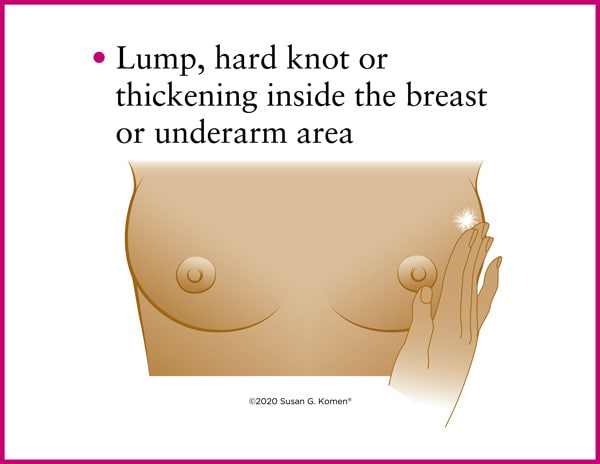
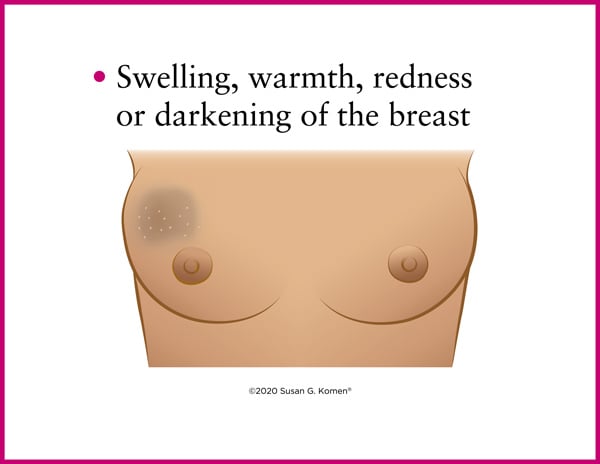
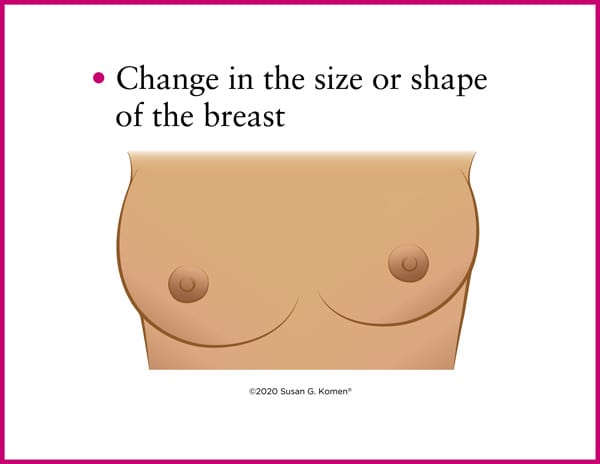
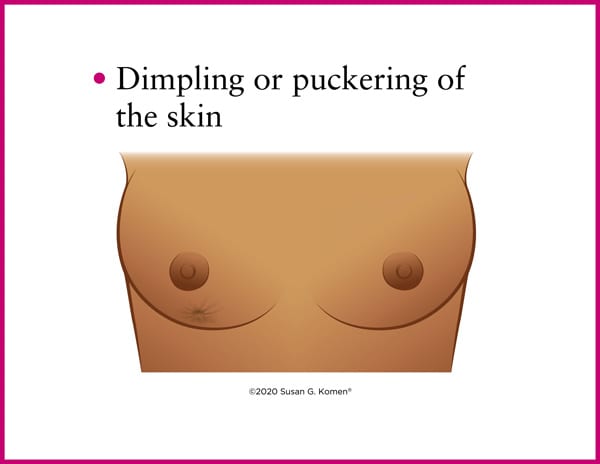
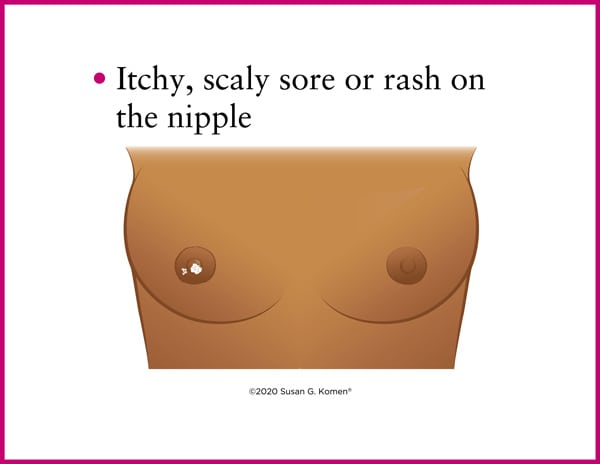
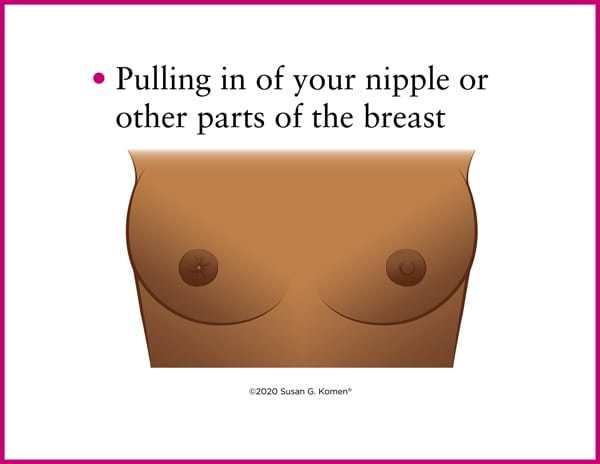
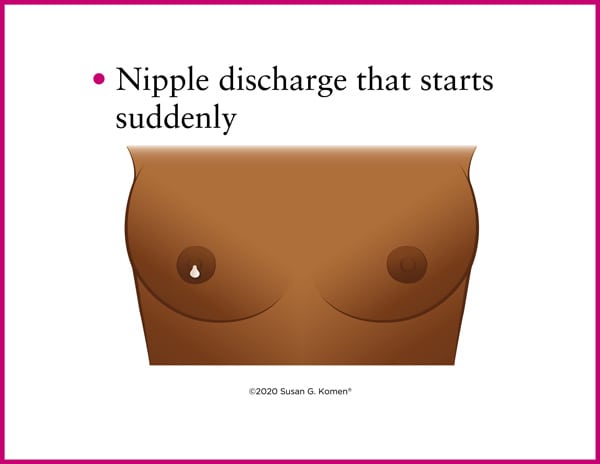
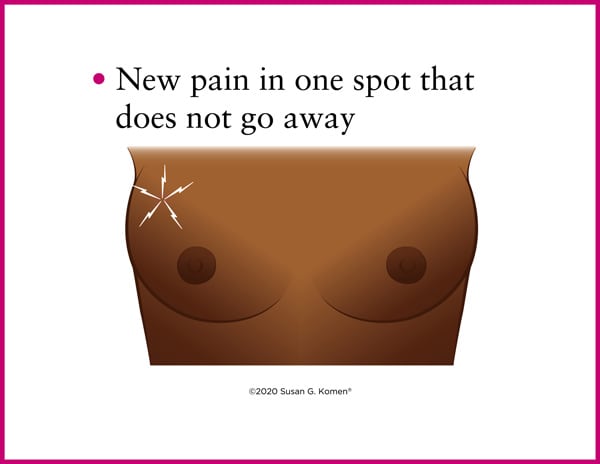
In most cases, these changes are not cancer. For example, breast pain is more common with benign (not cancer) breast conditions than with breast cancer. However, the only way to know for sure it’s not breast cancer is to get it checked.
If a change turns out to be breast cancer, it’s best to find it at an early stage when the chances of survival are highest.
Breast lumps or lumpiness
Many women find their breasts feel lumpy. Breast tissue naturally has a bumpy texture.
Some women have more lumpiness in their breasts than others. In most cases, this lumpiness is no cause to worry.
If the lumpiness can be felt throughout the breast and feels like your other breast, then it’s likely normal breast tissue.
Lumps that feel harder or different from the rest of the breast (or the other breast) or that feel like a change should be checked. This type of lump may be a sign of breast cancer or a benign (not cancer) breast condition, such as a cyst or fibroadenoma.
See a health care provider if you:
- Find a new lump (or any change) that feels different from the rest of your breast
- Find a new lump (or any change) that feels different from your other breast
- Feel something that’s different from what you felt before
If you’ve had a benign lump in the past, don’t assume a new lump will also be benign. The new lump may not be breast cancer, but it’s best to make sure.
Nipple discharge
Liquid leaking from your nipple (nipple discharge) can be troubling, but it’s rarely a sign of breast cancer.
Discharge can be your body’s natural reaction when the nipple is squeezed.
Signs of a more serious condition (such as breast cancer) include discharge that:
- Occurs without squeezing the nipple
- Occurs in only one breast
- Is bloody or clear (not milky)
Nipple discharge can also be caused by an infection or other condition that needs treatment.
If you have any nipple discharge, see a health care provider.
Finding a health care provider
If you don’t have a health care provider, one of the best ways to find a good one is to get a referral from a trusted family member or friend. You can also call your local health department or a nearby hospital or clinic. If you have insurance, your insurance company may also have a list of health care providers in your area.
Learn more about finding a health care provider.
Warning signs of breast cancer in men
The most common warning sign of breast cancer in men is a painless lump or thickening in the breast or chest area [123,125].
However, any change in the breast or nipple can be a warning sign of male breast cancer including [123,125]:
- Lump, hard knot or thickening in the breast, chest or underarm area (usually painless, but may be tender)
- Change in the size or shape of the breast
- Dimpling, puckering or redness of the skin of the breast
- Itchy, scaly sore or rash on the nipple
- Pulling in of the nipple (inverted nipple) or other parts of the breast
- Nipple discharge (rare)
These may also be signs of a benign (not cancer) breast condition.
Because men tend to have much less breast tissue than women, warning signs in men may be easier to notice than warning signs in women.
Learn more about male breast cancer.
Don’t delay seeing a health care provider
Some men may be embarrassed about a change in their breast or chest area. Others may not know it’s important to see a health care provider about a change. However, putting off seeing a provider may result in a delay in breast cancer diagnosis. Survival is highest when breast cancer is found early and treated.
If you notice any of the warning signs above or other changes in your breast, chest area or nipple, see a health care provider right away.
If you don’t have a health care provider, one of the best ways to find a good one is to get a referral from a trusted family member or friend. You can also call your local health department, or a nearby hospital or clinic. If you have insurance, your insurance company may have a list of health care providers in your area.
Learn more about finding a health care provider.
Updated 05/16/24
TOOLS & RESOURCES

In Your Own Words
How has having breast cancer changed your outlook?

